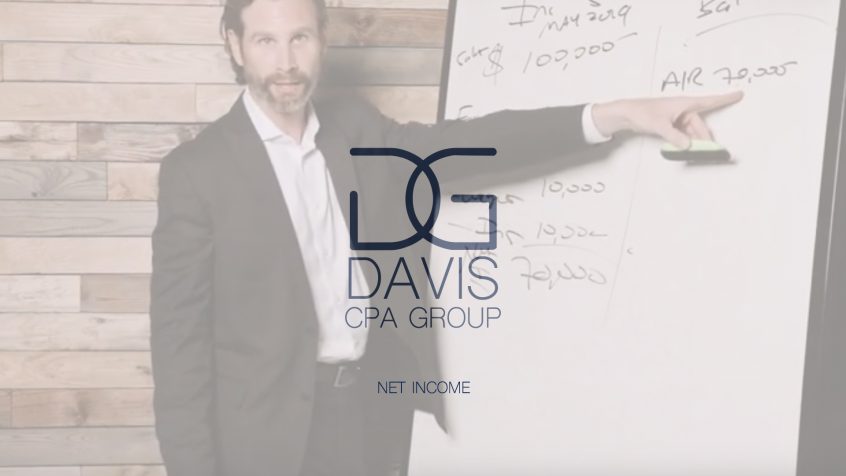Hi, Brandon Davis with Davis CPA Group. Today I am going to talk about net income versus cash flow of a transaction and also of just business operations. You may be asking me, “Well, aren’t those the same thing?” Well, sort of. Here’s what we’ve got.
So whenever a company is in business and we’re generating revenue, so let’s talk about our income statement. That’s what I’ll put up here. We’re looking at our income statement, we generate net income. And how we do that is we have sales. So let’s say in this fact pattern we’ve got $100,000 of sales. And we’ve got expenses, so let’s call this sales. And we’ve got expenses down here. So let’s say we maybe got utility expense, we’ve got wages, let’s see, insurance, what have you. And so we’ve got our expenses down here. So maybe there’s $10,000 in each one of those. I’m just going to keep this simple for talking purposes.
And so one might say, “All right, so we’ve got $30,000 in expenses against $100,000 in income, is going to give us $70,000 in profit or net income. Okay? Great. I made 70 grand. We’re doing awesome. Well maybe you are, maybe you’re not. One thing you’ve got to think about is the type of accounting method we’re using. So let’s say for example, in this fact pattern here, we’re under the accrual basis of accounting. I mean you all recognize my revenue when I send an invoice out. And I’m in a service industry and I have a lot of business type clients and a lot of times, I will send them an invoice and they’ll have 30 days to pay me.
And so in this statement here, let’s think about this. Say this is May of 2019 is what we’re dealing with. Let’s say we’ve got $100,000 that I’ve invoiced out. This is awesome. So it was great a month. Well, now I get to June. Okay, so now let’s draw a line here. Now we’re in June. June, I don’t do so good. So maybe I have $50,000 in invoices I send out. My expenses are about the same. So we’ve got 10K, 10K, 10K again and so this month, you know I only made 20 grand. I’m still doing okay, right? I mean I’m up to $80,000 of profits. Things are looking good. Kind of chucking in the line here. Well now I get to July and I can’t make payroll. And you’re like what? Why can you make payroll? You got $80,000 in profits. Well here’s why I can’t make payroll because I got another statement over here. And so I want to erase this. We had in our mind, we made 20 grand in June.
So now we’ll look at my balance sheet and I have another video we talk about the difference in the balance sheet and income statement. Well, this balance sheet, the 70 grand I made last month, it ain’t sitting in the bank account. It’s sitting in what’s called accounts receivable. My client’s owe me 70 grand. They haven’t paid me. I made it, I earned it. I’ve got expenses. I pay for those expenses out of my bank account. My bank account balance is going down because I’m covering this because I’m not collecting the accounts receivable.
So this is where you get in trouble, where you have a situation where you’re showing profit and let’s say maybe we’re at the end of June, now. Again, remember in June, you made another 20 grand. So that was what, $90,000 so I have $90,000 sitting in AR. I’ve not collected a single penny this money.
And so I’m trying to come up with the cash because, so now maybe on the balance sheet, which again as a quick refresher if you haven’t seen my other video, a balance sheet is a snapshot in time. It shows your cash position, your other assets like accounts receivable, people owe you money, who you owe money to and then down here you have an equity section. And so maybe my cash position is only five grand because every month I’ve been bleeding the cash reserves I had to cover these expenses to keep the business rolling. And so now I don’t have any cash, but I’m showing lots of profits. That’s where you get in trouble when you look at the standpoint of revenue that you’re making and not managing your cashflow. Cashflow is the most important part of a business in my opinion, is the part that keeps the business alive. I’d rather make less money here and make sure my cash position is high.
Now here’s something you could do. One of the things I tell my clients is if you’re offering terms to your customers where you put it, you send them a bill and they’ve got 30 or 45 days to pay you, along these expenses a lot of times you have 30 days to pay those, right? You get your utility bill on May 5th. It’s not due usually till June 5th and so you want to take advantage of those terms too and create what’s called accounts payable, meaning the expense hits my books as part of the factors here, but it’s not out of my cash yet. So if I said, okay, I’ve got 30 days to pay this $10,000 bill here, I’m going to set an AR. Well I just increased my cash by 10 grand because I haven’t paid it yet.
The expenses over here still shows my 70 grand, but I used to increased my cash by 15K. Oh there’s the 10K I needed to cover payroll. So that’s where cashflow a really becomes an integral part of managing a business. Understanding when to pay bills, when to send invoices. There are other ways to speed this process up. When you send your invoices out, maybe you reduce your terms, you drop it down to where you only give them 15 days to pay you. Maybe you give them an early pay discount, say, hey man, you pay me in the first five or 10 days, you’re going to get a percent or two off, whatever I invoiced you. So there’s tricks and tips that you can use to speed up this cashflow process, but also taking advantage of terms that you’re offered is very critical to do also.
Now, one other thing I want to look at relative to this is the cash flows of a particular transaction. So the other thing I was going to talk about is the cash flow of a transaction. So here we go. I’ll put a heading up here, I guess, cashflow of a transaction. Because again we’re talking about this whole video’s about net income versus cashflow, earnings or gain versus cashflow. I guess you can kind of tie it in two different scenarios here.
Let’s look at a transaction where I have a piece of property. Let’s say for example, I’ve got a piece of land that I bought for $50,000 and let’s say I have improved this property, I invested $100,000 in improvements. So maybe it was land I bought, let’s just say land and I put a building on it and then now it’s, my cost basis in this now is $150,000. That’s my cost. Well, land and buildings, they usually go up in value, right? So let’s say for example, the fair market value of this particular piece of property, now I’ve got $150,000 in it. It’s worth $200,000. Well, that’s pretty cool. Well, if I just had paid cash for everything and had never borrowed money to do it, if I sold it for $200,000, I would get $200,000 in cash coming to me. But I’d only pay tax on $50,000, the difference between my cost basis and we’re ignoring any depreciation or things out there and all you accounting reserves, that might be throwing comments out there. So we’re gonna ignore depreciation. We’ve got $50,000 in gain, if you will, that we pay tax on. That’s what everybody talks about paying taxes.
Well, let’s say for example, we borrowed money against this property. So you know, I’ve got $150,000 piece of property. It’s worth 200,000. Well, heck, I can get a bank to loan me the money. Let’s say I had to loan me a $180,000 on this property. So now they’ve loaned me more than I’ve got in it, but that’s okay because it’s worth $200,000 so they’re cool with that. And I maybe I use this money over here in another business and venture or investment or what have you. Well, so we have the same fact pattern show up. You know what I’ve had this property for a while and someone’s offered to maybe pay 200,000 for it. I haven’t paid the bank yet back. That’s okay. So I get the $200,000 now that I get and I pay off my loan. And so now I still have $50,000 in the same gain, but my cash I received is only $20,000 and you made whoa, I gotta pay tax on 50 million but I only got 20 well, because that’s the difference between the cash flow of a transaction and the gain loss situation of a transaction.
You know I have clients that sometimes get a little frustrated with that because they’ll have situations where maybe in our fact pattern, we’ve taken depreciation against this property, which means we would drop the balance of the value even further from a cost basis perspective. Maybe we took 50 grand in depreciation on this property. Well now my basis, my adjusted basis would be a 100K, my gain would be $100,000 but I only got $20,000 in taxes. If I’m at a 20% effective tax rate, I barely got enough cash to pay off the debt or I may barely have enough cash to pay the taxes when I paid the debt off. So I got no money out of this thing I sold for $200,000.
It’s not a terrible thing. This is something you’ve got to think about. You should always consider the cash flows of a transaction before you enter into it and say, well, what have I leveraged and why? Did it make sense at the time to do it and will I have enough cash to cover the tax liability? That’s what you always, when you go into a major transaction, you want to do some tax planning, projection work and make sure you have all your bases covered.
Another video from Davis CPA Group. Happy to help with these things as they develop and thank you for watching.


